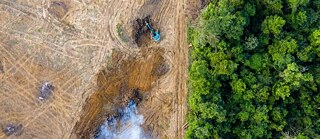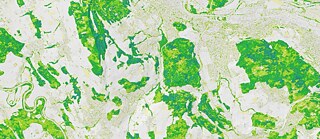Environmental Protection and Technology “A Renaissance of Nature”

Can modern technologies be used profitably to foster conservation and restore lost trust? Software engineer David Dao is convinced that they can, which is why he launched the non-profit GainForest fund. In our interview he talks about his personal relationship with nature, how GainForest came about and about the considerable influence that indigenous communities have on his work.
David Dao, GainForest is all about using modern technologies such as artificial intelligence to help protect nature. You yourself have a background in Silicon Valley, a place that hardly triggers associations with unspoilt nature – how did the idea of combining technology and conservation come about?
It’s true that there is not a lot of nature in Silicon Valley itself, though it’s actually really beautiful a bit further out in the Bay Area. I’ve been interested in climate change ever since my time at school. When I was at secondary school I watched Al Gore‘s film An Inconvenient Truth, which came as quite a shock to me. My parents originally come from the Vietnamese rainforest, and I myself grew up in the Black Forest, so forests and climate change were always linked in my mind. The trigger came when I left Silicon Valley because I wanted to use my skills to do some good. I spent many months travelling through Asia, during which time I lived with local communities and completely by chance ended up applying for a United Nations hackathon. And suddenly it all just clicked: my work in Silicon Valley, where we did a lot with artificial intelligence (AI), the communities, the forest – it occurred to me that AI could actually be used to monitor and protect forests. Five years ago, this hackathon led to GainForest, an idea we have not been able to get out of our minds ever since.
Which specific applications are there for modern technologies to complement and possibly improve on conventional approaches to conservation?
Our modern society is not really connected to nature, which is why conservation is often underfunded. It is therefore important to use the money we do have efficiently. When it comes to protecting huge forests like the Amazon, this means understanding which regions are most at risk and which require particular protection. AI can help us predict where there is a risk of illegal deforestation and where it makes best sense to plant new trees to capture CO2 from the atmosphere. However, algorithms can also be used to assess the value of nature. It is always important to know the value of things for investments. With the aid of technology, it is possible to precisely calculate a forest’s “output” in terms of how much water it cleans and how much oxygen it produces; this all has a market value for society that can be measured accurately using algorithms.
One key concept that GainForest works with is the use of trust-enhancing technologies. To what extent can technology help generate increased trust and confidence when so many people have a lack of trust in technology, and especially in major multinational tech companies?
We lose our trust in tech companies because they are monopolies. Google dominates our internet searches and Facebook dominates our social media. This must change – in any fair and good society, shared responsibility and mutual monitoring must be guaranteed. Such decentralization of power was actually the original idea behind the internet. Our approach at GainForest is as follows: at first people will have to trust our algorithms, our assessments and our measurements. But in the long term our platform will be open to anyone wishing to contribute their own algorithms. Currently we are running a scholarship programme within the organization to support researchers from the Global South – from Africa, South America, Southeast Asia – who often do not have a voice in the technology sector. The programme is intended to provide incentives for them to create their own models and gather their own data, which we will then publish on the platform – indicating of course where the datasets come from. We hope that this will make the GainForest platform more decentralized and that it will in time be dominated by the people who develop algorithms and collect data. In the interests of transparency, we also put all raw data we work with onto a blockchain and hope that this transparency of algorithms and open code will restore more of the trust in technology that has been lost in many cases.
The ethical handling of data is a key issue in future activities involving AI-based technologies. How does GainForest approach the problem of bias in existing datasets and models?
I am in the process of completing my PhD at ETH Zurich, and one of the most important findings that we have published is the following: the central algorithms that we currently use to measure for example where and how much biomass is present in a forest were naturally developed on the basis of the data we have. And most of the data we have at the moment still comes from North America and Europe, which of course means that the algorithms are distorted. It is very obvious when we make a prediction that this works super well in the context of the USA and for large areas, but very badly for small areas in South America and not at all for Africa. And that is of course a problem, as you don’t want to have to say when using algorithms for communities in the Global South: “Sorry, our algorithm works really badly for you, tough luck!” That’s why we are actively sponsoring research in these regions and investing money to improve the infrastructure in our pilot regions in the Philippines, Africa and South America. The only way to fight bias is to create a fair dataset, and this also means paying those involved a fair wage and integrating them into the projects.

Your entire work is based on the idea of learning from nature’s stewards. Why is it so important to collaborate with indigenous populations on an equal footing?
I believe that there is a particular lack of humility in our technology sector. We always think we have all the solutions for this world, but that simply isn’t true. Often we develop something and only then realize that it is not being used by other regions in the world. We must develop things that are actually used, but this first involves understanding what in fact is needed. From the start, it was important to us not to simply implement our preconceived ideas. GainForest itself wouldn’t even exist without the indigenous communities. Once we had won the hackathon project, that was initially the end for us. It was only when we began collaborating with the indigenous Kayapó community that we were really able to realize our project. We were so excited by the way we were able to work as a team to support the Kayapó community in its conservation activities. First, however, we had to learn a lot from them.
Can you give any concrete examples of how the project profited from the worldview and ideas of the indigenous groups such as the Kayapó in Brazil’s Amazon region?
At first, we used a not particularly energy-efficient blockchain to store the data groups. This met with considerable criticism in the communities, forcing us to rethink: it was fine to use technology, yes, but not at any cost. We then modified the platform and switched to an energy-efficient blockchain. That was the first direct lesson we learnt. We learnt our second lesson when we developed a model which envisaged each individual being paid: the more trees people entered into the app, the more money they would receive. But then we were told by the indigenous communities that it is not sensible to pay every individual person because this leads to competition. In the Kayapó culture everyone works together, without any concept of competition. This gave us some serious food for thought. Now we have more of a hierarchical system in which we trust the elders to organize everything and distribute the money fairly. Those are things you cannot learn just by sitting at your computer. At the end of the day, that’s actually my favourite part of the work: experiencing nature at the local level while at the same time communicating with the local communities and understanding what they really need and how money can be distributed most efficiently.
Protecting the environment and preserving habitats are a central part of the cultural identity of the Kayapó. To what extent could this generate impetus for the global environmental protection movement?
It always makes me sad when I go to COP and everyone is talking about the indigenous communities, but yet again only people from Europe are sitting on the panel. I believe that we can really learn a lot from them, but the first step is to actually invite them to the meetings. This is again the problem of the lack of humility in the technology sector. We think we can talk about everyone and represent everyone, but I do not believe that I can report in a panel about indigenous peoples and their knowledge. They simply have such a different yet fascinating way of viewing the world. I feel that we as a society are currently experiencing a renaissance of nature. Especially during the pandemic, we gradually began to appreciate nature again, though we still remain very detached from nature. One think I always like to try is to shut my eyes and imagine nature. Most people in Germany and Europe see rivers, mountains or forests when they do this, but no humans. When the indigenous peoples shut their eyes, however, they see themselves. I think that’s so great! That is something we can learn from them – to find our way back to nature time and again, to establish a bond, to build a bridge. After all, when you feel disconnected from nature, you cannot really appreciate it.
Mr. Dao, you recently attended the UN Climate Change Conference COP27 in Sharm el Sheikh. Which ideas from there will you be taking for your own work with GainForest in the coming years?
Ever since attending our first climate summit five years ago, our team has been to every global climate summit. Unfortunately, we have also seen that not much has changed, at least with respect to rising carbon emissions. It is also noticeable quite often that the various actors promise a lot but do not deliver a lot. That is something that especially motivates our work at GainForest. We simply must be able to measure what is changing. We cannot just believe what people say – we must use transparent data and algorithms to show that many promises simply aren’t implemented. Our goal therefore is to make transparent global data available. There is one thing that makes me hopeful, however. One group has achieved a huge amount at the world climate summits in the last five years: young activists. They themselves have set up programmes to provide funding for delegates from the Global South who normally do not have enough money to fly to the climate conferences in the first place. Furthermore, they have brought hundreds of delegates from indigenous peoples to the UN Climate Change Conference, training them and giving them a voice. I believe that a transformation is coming about because lots of people are refusing to simply wait for something to happen, and instead are now taking the initiative. That is also the mission of GainForest. The less time we have, the more we must act ourselves. Let’s see what else we can achieve in the next few years.
Thank you! It is nice to end on such a hopeful note.
Background
GainForest is an interdisciplinary and international non-profit association based in Zurich. It is made up of engineers, policy-makers and researchers from Germany, the USA, the UK, Indonesia and Argentina.
The goal of GainForest is to reverse the deterioration of nature and in particular to counter global deforestation. To this end, technologies such as artificial intelligence (AI) and drones are used to analyse and categorize natural areas that are worth protecting and to make their value clearly visible to society.
A community-based approach is central to the work done by GainForest and involves collaborating on an equal footing with indigenous communities. The objective is to learn from indigenous methods of protecting nature and to create decent and sustainable work for those populations threatened by climate change.


